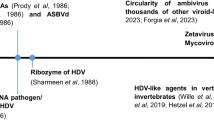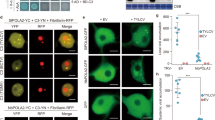Abstract
Viruses typically encode the capsid that encases their genome, while satellite viruses do not encode a replicase and depend on a helper virus for their replication1. Here, we report interplay between two RNA viruses, yado-nushi virus 1 (YnV1) and yado-kari virus 1 (YkV1), in a phytopathogenic fungus, Rosellinia necatrix2. YkV1 has a close phylogenetic affinity to positive-sense, single-stranded (+)ssRNA viruses such as animal caliciviruses3, while YnV1 has an undivided double-stranded (ds) RNA genome with a resemblance to fungal totiviruses4. Virion transfection and infectious full-length cDNA transformation has shown that YkV1 depends on YnV1 for viability, although it probably encodes functional RNA-dependent RNA polymerase (RdRp). Immunological and molecular analyses have revealed trans-encapsidation of not only YkV1 RNA but also RdRp by the capsid protein of the other virus (YnV1), and enhancement of YnV1 accumulation by YkV1. This study demonstrates interplay in which the capsidless (+)ssRNA virus (YkV1), hijacks the capsid protein of the dsRNA virus (YnV1), and replicates as if it were a dsRNA virus.
This is a preview of subscription content, access via your institution
Access options
Subscribe to this journal
Receive 12 digital issues and online access to articles
$119.00 per year
only $9.92 per issue
Buy this article
- Purchase on Springer Link
- Instant access to full article PDF
Prices may be subject to local taxes which are calculated during checkout



Similar content being viewed by others
References
Simon, A. E., Roossinck, M. J. & Havelda, Z. Plant virus satellite and defective interfering RNAs: new paradigms for a new century. Annu. Rev. Phytopathol. 42, 415–437 (2004).
Kondo, H., Kanematsu, S. & Suzuki, N. Viruses of the white root rot fungus, Rosellinia necatrix. Adv. Virus Res. 86, 177–214 (2013).
Koonin, E. V. & Dolja, V. V. Virus world as an evolutionary network of viruses and capsidless selfish elements. Microbiol. Mol. Biol. Rev. 78, 278–303 (2014).
Wickner, R. B., Ghabrial, S. A., Nibert, M. L., Patterson, J. L. & Wang, C. C. in Virus Taxonomy: Ninth Report of the International Committee for the Taxonomy of Viruses (eds King, A. M. Q., Adams, M. J., Carstens, E. B. & Lefkowits, E. J. ) 639–650 (Elsevier, 2011).
Ghabrial, S. & Suzuki, N. Viruses of plant pathogenic fungi. Annu. Rev. Phytopathol. 47, 353–384 (2009).
Suttle, C. A. Marine viruses—major players in the global ecosystem. Nature Rev. Microbiol. 5, 801–812 (2007).
Nagasaki, K. Dinoflagellates, diatoms, and their viruses. J. Microbiol. 46, 235–243 (2008).
Dunigan, D. D., Fitzgerald, L. A. & Van Etten, J. L. Phycodnaviruses: a peek at genetic diversity. Virus Res. 117, 119–132 (2006).
Colson, P. et al. ‘Megavirales’, a proposed new order for eukaryotic nucleocytoplasmic large DNA viruses. Arch. Virol. 158, 2517–2521 (2013).
Raoult, D. et al. The 1.2-megabase genome sequence of Mimivirus. Science 306, 1344–1350 (2004).
Hillman, B. I. & Suzuki, N. Viruses of the chestnut blight fungus, Cryphonectria parasitica. Adv. Virus Res. 63, 423–472 (2004).
Taliansky, M. E. & Robinson, D. J. Molecular biology of umbraviruses: phantom warriors. J. Gen. Virol. 84, 1951–1960 (2003).
Sabanadzovic, S., Valverde, R. A., Brown, J. K., Martin, R. R. & Tzanetakis, I. E. Southern tomato virus: the link between the families Totiviridae and Partitiviridae. Virus Res. 140, 130–137 (2009).
Hillman, B. I. & Cai, G. The family Narnaviridae: simplest of RNA viruses. Adv. Virus Res. 86, 149–176 (2013).
Chiba, S., Lin, Y. H., Kondo, H., Kanematsu, S. & Suzuki, N. A novel victorivirus from a phytopathogenic fungus, Rosellinia necatrix is infectious as particles and targeted by RNA silencing. J. Virol. 87, 6727–6738 (2013).
Yaegashi, H., Yoshikawa, N., Ito, T. & Kanematsu, S. A mycoreovirus suppresses RNA silencing in the white root rot fungus, Rosellinia necatrix. Virology 444, 409–416 (2013).
Yaegashi, H. et al. Appearance of mycovirus-like double-stranded RNAs in the white root rot fungus, Rosellinia necatrix, in an apple orchard. FEMS Microbiol. Ecol. 83, 49–62 (2013).
Lin, Y. H. et al. A novel quadripartite dsRNA virus isolated from a phytopathogenic filamentous fungus, Rosellinia necatrix. Virology 426, 42–50 (2012).
Dinman, J. D., Icho, T. & Wickner, R. B. A -1 ribosomal frameshift in a double-stranded RNA virus of yeast forms a gag–pol fusion protein. Proc. Natl Acad. Sci. USA 88, 174–178 (1991).
Salaipeth, L., Chiba, S., Eusebio-Cope, A., Kanematsu, S. & Suzuki, N. Biological properties and expression strategy of Rosellinia necatrix megabirnavirus 1 analyzed in an experimental host, Cryphonectria parasitica. J. Gen. Virol. 95, 740–750 (2014).
Liu, H. et al. Evolutionary genomics of mycovirus-related dsRNA viruses reveals cross-family horizontal gene transfer and evolution of diverse viral lineages. BMC Evol. Biol. 12, 91 (2012).
Ikeda, Y., Shimura, H., Kitahara, R., Masuta, C. & Ezawa, T. A novel virus-like double-stranded RNA in an obligate biotroph arbuscular mycorrhizal fungus: a hidden player in mycorrhizal symbiosis. Mol. Plant Microbe Interact. 25, 1005–1012 (2012).
Jiang, D. & Ghabrial, S. A. Molecular characterization of Penicillium chrysogenum virus: reconsideration of the taxonomy of the genus Chrysovirus. J. Gen. Virol. 85, 2111–2121 (2004).
Kozlakidis, Z., Herrero, N., Ozkan, S., Bhatti, M. F. & Coutts, R. H. A novel dsRNA element isolated from the Aspergillus foetidus mycovirus complex. Arch. Virol. 158, 2625–2628 (2013).
Ahlquist, P. Parallels among positive-strand RNA viruses, reverse-transcribing viruses and double-stranded RNA viruses. Nature Rev. Microbiol. 4, 371–382 (2006).
Barajas, D., Martin, I. F., Pogany, J., Risco, C. & Nagy, P. D. Noncanonical role for the host Vps4 AAA+ ATPase ESCRT protein in the formation of tomato bushy stunt virus replicase. PLoS Pathogens 10, e1004087 (2014).
Fahima, T., Kazmierczak, P., Hansen, D. R., Pfeiffer, P. & Van Alfen, N. K. Membrane-associated replication of an unencapsidated double-strand RNA of the fungus, Cryphonectria parasitica. Virology 195, 81–89 (1993).
Wickner, R. B., Fujimura, T. & Esteban, R. Viruses and prions of Saccharomyces cerevisiae. Adv. Virus Res. 86, 1–36 (2013).
Baltimore, D. Expression of animal virus genomes. Bacteriol. Rev. 35, 235–241 (1971).
Vainio, E. J. et al. Population structure of a novel putative mycovirus infecting the conifer root-rot fungus Heterobasidion annosum sensu lato. Virology 422, 366–376 (2012).
Rastgou, M. et al. Molecular characterization of the plant virus genus Ourmiavirus and evidence of inter-kingdom reassortment of viral genome segments as its possible route of origin. J. Gen. Virol. 90, 2525–2535 (2009).
Koonin, E. V., Wolf, Y. I., Nagasaki, K. & Dolja, V. V. The Big Bang of picorna-like virus evolution antedates the radiation of eukaryotic supergroups. Nature Rev. Microbiol. 6, 925–939 (2008).
Kanematsu, S. et al. A Reovirus causes hypovirulence of Rosellinia necatrix. Phytopathology 94, 561–568 (2004).
Chiba, S. et al. A novel bipartite double-stranded RNA mycovirus from the white root rot fungus Rosellinia necatrix: molecular and biological characterization, taxonomic considerations, and potential for biological control. J. Virol. 83, 12801–12812 (2009).
Hillman, B. I., Supyani, S., Kondo, H. & Suzuki, N. A reovirus of the fungus Cryphonectria parasitica that is infectious as particles and related to the Coltivirus genus of animal pathogens. J. Virol. 78, 892–898 (2004).
Sasaki, A., Kanematsu, S., Onoue, M., Oyama, Y. & Yoshida, K. Infection of Rosellinia necatrix with purified viral particles of a member of Partitiviridae (RnPV1-W8). Arch. Virol. 151, 697–707 (2006).
Eusebio-Cope, A. & Suzuki, N. Mycoreovirus genome rearrangements associated with RNA silencing deficiency. Nucleic Acids Res. 43, 3802–3813 (2015).
Lin, Y. H., Hisano, S., Yaegashi, H., Kanematsu, S. & Suzuki, N. A second quadrivirus strain from the phytopathogenic filamentous fungus Rosellinia necatrix. Arch. Virol. 158, 1093–1098 (2013).
Segers, G. C., Regier, J. C. & Nuss, D. L. Evidence for a role of the regulator of G-protein signaling protein CPRGS-1 in G alpha subunit CPG-1-mediated regulation of fungal virulence, conidiation, and hydrophobin synthesis in the chestnut blight fungus Cryphonectria parasitica. Eukaryot. Cell 3, 1454–1463 (2004).
Charoenpanich, J., Tani, A., Moriwaki, N., Kimbara, K. & Kawai, F. Dual regulation of a polyethylene glycol degradative operon by AraC-type and GalR-type regulators in Sphingopyxis macrogoltabida strain 103. Microbiology 152, 3025–3034 (2006).
Suzuki, N., Sugawara, M., Nuss, D. L. & Matsuura, Y. Polycistronic (tri- or bicistronic) phytoreoviral segments translatable in both plant and insect cells. J. Virol. 70, 8155–8159 (1996).
Kondo, H., Chiba, S., Toyoda, K. & Suzuki, N. Evidence for negative-strand RNA virus infection in fungi. Virology 435, 201–209 (2013).
Acknowledgements
The authors acknowledge Yomogi Inc. (N.S.) and the Science and Technology Research Promotion Program for Agriculture, Forestry, Fisheries and food Industry (25032AB) (S.K. and N.S.) for financial support during this study. The authors thank R. Dietzgen, K. Hyodo and I.B. Andika for discussions and critical reading of the manuscript. The authors are also grateful to T. Shiokawa and H. Tada at the Division of Instrumental Analysis, Okayama University, for the amino-acid sequence analyses.
Author information
Authors and Affiliations
Contributions
S.K. and N.S. designed the research. R.Z., S.H., A.T. and H.K. performed the experiments. S.K. contributed fungal materials. H.K., A.T. and N.S. analysed the data. N.S. wrote the paper. All authors discussed the results and commented on the manuscript.
Corresponding author
Ethics declarations
Competing interests
The authors declare no competing financial interests.
Supplementary information
Supplementary Information
Supplementary Figures 1–5 and Tables 1–4. (PDF 4752 kb)
Rights and permissions
About this article
Cite this article
Zhang, R., Hisano, S., Tani, A. et al. A capsidless ssRNA virus hosted by an unrelated dsRNA virus. Nat Microbiol 1, 15001 (2016). https://doi.org/10.1038/nmicrobiol.2015.1
Received:
Accepted:
Published:
DOI: https://doi.org/10.1038/nmicrobiol.2015.1
This article is cited by
-
A novel narnavirus isolated from Colletotrichum curcumae strain 780-2T
Archives of Virology (2023)
-
Sequence and phylogenetic analysis of a novel alphaendornavirus, the first virus described from the oomycete plant pathogen Phytophthora heveae
Archives of Virology (2023)
-
Studies on the interactions of Rosellinia necatrix and mycoviruses for sustainable management of white root rot of fruit trees
Journal of General Plant Pathology (2023)
-
Diversity of mycoviruses in edible fungi
Virus Genes (2022)
-
A novel mycovirus infecting Aspergillus nidulans that is closely related to viruses in a new genus of the family Partitiviridae
Archives of Virology (2021)



